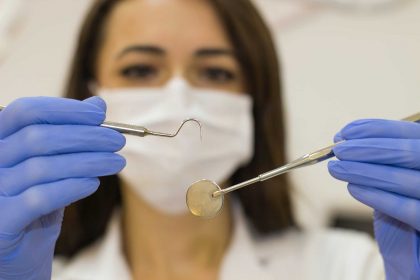Brushing your teeth regularly is an important first step toward healthy teeth and gums. But it’s also important that you brush your ivories the right way. That means using the right toothbrush, using the right amount of pressure, using the right stroke, and brushing every tooth surface and along the gum line.
The best way to brush your teeth is to use a soft-bristled brush and to brush each tooth with a gentle, circular motion. Make sure to brush each tooth’s outside surface (next to the cheek) and the inside surface (next to the tongue) and the chewing surface. Along the gum line, hold the brush at a 45-degree angle to gently clean the gums.
You should spend no less than two minutes brushing your entire mouth, and you should do this at least twice a day — once when you get up in the morning to remove the smear layer, and again before bed.
A third brushing sometime after lunch is also helpful, but don’t brush your teeth immediately after eating. Allow at least fifteen minutes for the acids from your food to flush away, or at least rinse your mouth first if you need to brush right after a meal.
Key considerations when brushing your teeth
The whole point of brushing your teeth is to clear away the dental plaque — a sticky, colorless biofilm — before it has the chance to get comfortable and start causing problems. There is always plaque in your mouth, and there’s nothing that you can do about that. But thorough brushing at least twice a day is enough to keep it from accumulating and hardening into tartar. Once this tartar forms, the process of developing cavities and gum disease has already begun, and the only way to correct it is with a visit to the dentist.
It doesn’t take much effort to clean unhardened plaque from your teeth. In fact, using a lot of pressure to push the brush head against your teeth can be counterproductive and even damaging. You don’t want to push so hard that the bristles turn away from the tooth or scratch the enamel or aggravate the gums. Think of it as more of a gentle massage for your teeth. That’s all it takes to remove plaque — again, as long as you brush at least twice a day so the plaque doesn’t have a chance to build up and start to harden against your teeth.
You also want to use a soft-bristled toothbrush. Hard bristles are more likely to scratch, and they do a poor job of cleaning at the gum line.
And you need to change your toothbrush head regularly, at least once every three to four months or sooner if it shows signs of wear. If it’s been longer than three or four months, please invest in a new brush (or head).
Manual vs. electric toothbrushes
Studies have shown that brushing your teeth as suggested above — twice a day, for two minutes each time — with a manual toothbrush is sufficient to prevent the buildup of plaque. So a manual toothbrush in tip-top condition is all you really need.
However, a high quality electric toothbrush is much easier to use, and likely does an even better job at removing plaque when used properly. Many electric toothbrushes also incorporate built-in timers to make sure you’re brushing for the appropriate amount of time. When using an electric toothbrush, you don’t need to worry about stroking the brush. You just turn it on, hold it lightly against the tooth, and let the vibrating bristles do all the work. Your only job is to angle it and move it around to all the different tooth surfaces. With an electrical toothbrush, it’s also easier to avoid the temptation of pressing too hard when you brush.
Do you need to use toothpaste when you brush?
Studies have shown that toothpaste isn’t technically necessary when it comes to removing plaque. A toothbrush moistened with water and no toothpaste is just as effective. However, some toothpastes are formulated for more than just removing plaque. They might also include whitening agents, fluoride for strong teeth, or even formulations for reducing tooth sensitivity. At the very least, a good toothpaste (aka dentifrice) leaves a nice, fresh taste in your mouth after brushing.
Brush regularly, brush thoroughly, and brush gently
The most important things to keep in mind are these:
- Brush your teeth twice a day, for at least two minutes each time.
- Be sure to brush every tooth surface in your mouth — top, sides, back, front, and in between when possible.
- Don’t press too hard. A gentle, circular motion should be enough.
- Don’t use a shabby old brush head. Change it out for a new one.
- Floss once a day to get those in-between spaces that your brush misses.
- Invest in a water irrigator if you can. It’s a great addition to your oral hygiene regimen.
- Have your teeth cleaned professionally a couple times a year or as often as recommended by your dentist.




